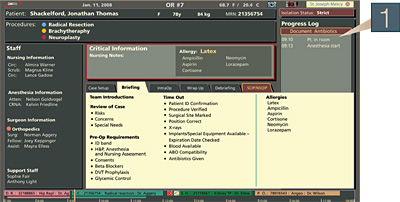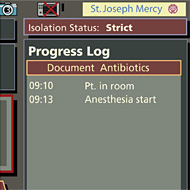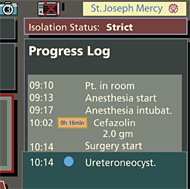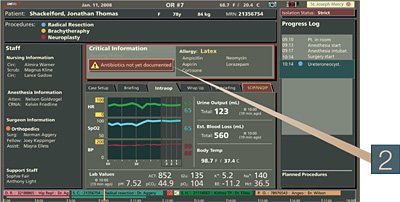SCIP Compliance and the Role of Concurrent Documentation
January / February 2008
SCIP Compliance and the Role of Concurrent Documentation
Surgical complications in the U.S. account for 2.4 million days of patient hospital stay at a charge of $9.3 billion (Supplement on SCIP, 2007). The Surgical Care Improvement Project (SCIP), a Centers for Medicare & Medicaid Services (CMS) initiative, targets the reduction in complications through evidence-based care. SCIP sets specific guidelines to help hospitals reduce the incidence of postoperative surgical site infections, perioperative cardiac events, deep vein thrombosis, and postoperative ventilator-associated pneumonia, all of which have been identified as major contributors to surgical complications.
SCIP creates several challenges for hospitals, notably:
- adhering to SCIP guidelines, making them part of standard hospital practice to improve surgical care;

- meeting CMS reporting requirements; and

- identifying and correcting deficiencies that can impact reimbursement by as much as 2%.
St. Joseph Mercy Hospital (SJMH) in Ann Arbor, Michigan, is taking an aggressive approach toward SCIP in all these respects, with particular emphasis on improving the quality of care, with the help of real-time data integration technology.
SJMH is implementing software from LiveData, Inc., that will monitor SCIP compliance and enable “concurrent documentation.” This refers to concurrently assessing the need to document a task, determining that it has been done, or providing clear reminders visible to the entire team until documentation has taken place. For example, when a patient enters the OR, a reminder will appear, stating the need to document administration of the prophylactic antibiotic. Increasingly vivid reminders will help ensure that documentation is done.
Currently, SJMH’s SCIP reporting process involves the manual abstraction of data from the medical record. At SJMH, this abstraction process takes roughly 3 months. In the absence of concurrent documentation, there is no effective way to review all case documentation, identify issues relating to SCIP, and take action. Consequently, documentation errors and potential flaws in SCIP compliance are not likely to be identified and addressed until 3 months have passed.
Concurrent documentation will ensure that the information is available for analysis and reporting. This in turn will enable staff to assess compliance with SCIP guidelines, identify documentation errors that can impact reimbursement, and work with the team to respond accordingly.
SJMH is deploying LiveData OR-Dashboard to implement concurrent documentation in 17 operating rooms. The software captures critical information in real-time from diverse information systems and medical devices, synthesizes it, and presents it on a large flat-panel display, visible to the entire OR team. During the surgical case, OR-Dashboard will alert staff to the need to document key SCIP-related measures. If documentation does not occur, visual reminders will persist and become more vivid, helping to ensure that proper documentation occurs.
An important focus at SJMH is reducing the incidence of postoperative infection. Nationally, surgical site infections account for 14% to 16% of all hospital-acquired infections; 40% of the 42 million surgeries performed each year are associated with postoperative infections (Joint Commission, 2005). It has been estimated that reducing these infections can decrease extended patient stays by as much as 7 days and save hospitals over $3,000 per patient (ACS, 2005). Under SCIP guidelines, recommendations for preventing surgical site infections include the appropriate use of prophylactic antibiotics, the use of appropriate hair removal methods, glucose control in patients undergoing major cardiac surgery, and maintenance of proper body temperature (normothermia) in patients undergoing colon surgery (Daniels, 2007).
The goal of prophylactic antibiotic therapy administered before surgery is to protect the patient from infection. Delivering the prophylactic dose just before incision time has produced the best results in preventing surgical site infections. The IHI, SCIP, and CMS/Joint Commission quality performance initiatives have agreed to use 60 minutes prior to incision for measurement purposes. Vancomycin and fluoroquinolones may be given up to 2 hours before incision because of their longer infusion times (Daniels, 2007).
The sidebar on page 38 (see below), highlighting prophylactic antibiotic administration, shows concurrent documentation in use. The dashboard features an antibiotic timestamp, so that the entire team can see when the antibiotic was administered and know when they are approaching the 1- or 2-hour limit prior to surgery start. Additionally, the dashboard features a “count-up timer” to help the team keep an eye on when it might be time to redose the patient in a long-running case. After the case, using real-time data archiving and reporting capabilities, a hospital can analyze the day’s cases, spot instances where measures fall outside SCIP recommendations, and review these with team members.
|
Seemingly careless documentation errors often stem from misinformation or misunderstandings. These are relatively easy to identify and correct, shortly after the operation, if the data is available for review. In a recent case, for example, perioperative staff did not specify “IV” because the assumption was that the route for antibiotic administration was always intravenous, unless otherwise noted. Because CMS requires that all details be documented, and “IV” was not spelled out, reimbursement relating to a batch of reports was adversely affected. SJMH expects the new system to enable the reduction, if not complete elimination, of such errors.
SJMH sees a major opportunity to use state of the art information technology to significantly improve the quality of surgical care, increase compensation, and reduce costs. Going beyond the antibiotic example, concurrent documentation can be employed to document and help increase compliance with normothermia, blood glucose, and other SCIP measures. Over time, as key metrics are documented and entered into the electronic medical record, manual processes will give way to automatic data abstraction, reducing reporting costs and improving the hospital’s ability continually assess and streamline operations.
Kevin Brennan is the quality and integration lead for St. Joseph Mercy Hospital Surgery Service in Ann Arbor, Michigan, and is currently responsible for coordinating quality improvement initiatives within the OR services. He has been the chief perfusionist for the Open Heart Program at St. Joseph Mercy Hospital in Ann Arbor, Michigan, since 1988. He has been affiliated with St. Joseph Mercy Hospital since 1977 and was credentialed as a Certified Clinical Perfusionist in 1983. He holds a master’s degree in health administration and completed the training as a Six Sigma Black Belt/Guide in August 2004.
Gabriel Spitz is director of human factors at LiveData. He played a leading role in developing the user interface of LiveData OR-Dashboard and is responsible for analysis and design of new features, add-ons, and expansions for the dashboard. He has more than 20 years of experience in the application of human factors and usability principles to the design and evaluation of interactive human-technology systems. Spitz holds a doctorate of science degree in human factors and behavioral sciences, an MSIE in human factors, and a BA in psychology. Before joining LiveData, he was a lead group scientist at Aptima, where his work included the design and evaluation of command teams for 21st Century Navy destroyers. Spitz may be contacted at gspitz@livedata.com.
References
American College of Surgeons. (2005, September 9). Pay for performance: Developing a quality improvement framework for surgical care. Available at http://www.facs.org/ahp/views/payforperformance.html
Daniels, S. M. (2007, August). Protecting patients from harm: Improving hospital care for surgical patients. Nursing 2007, 37(8).
Joint Commission International Center for Patient Safety. (2005, November). When quality improvement meets surgery, complications will plummet. Available at http://www.jcipatientsafety.org/15194/
Supplement on the Surgical Care Improvement Project (SCIP). (2007, March). OR Manager 23(3).




